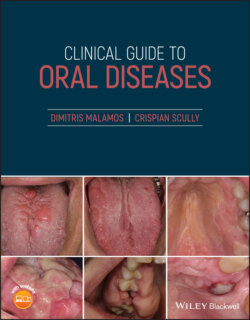Читать книгу Clinical Guide to Oral Diseases - Crispian Scully - Страница 19
Case 1.5
ОглавлениеFigure 1.5
CO: A 48‐year old man was presented with a hemorrhagic lesion on the floor of his mouth.
HPC: The lesion appeared six months ago while the bleeding was noticed during eating three days ago.
PMH: No serious medical problems were recorded apart from an episode of severe pneumonia which was diagnosed last December and was treated with a strong course of antibiotics. No other drugs were taken, but the patient was a smoker (>40 cigarettes, daily) and a drinker (4–5 glasses of wine or relevant spirit per meal).
OE: The examination revealed an asymptomatic white lesion on the floor of mouth extended from the left lower premolar to the molar region. The lesion was fixed in palpation and had a warty‐like surface with two to three bleeding areas (Figure 1.5). Smoking‐induced lesions such as increased gingival pigmentation, nicotinic stomatitis and brown teeth discoloration were also found, together with ipsilateral, fixed, enlarged cervical lymph nodes where oral or skin petechiae and ecchymoses were not seen.
Q1 What is the cause of bleeding?
1 Traumatic ulceration
2 Pemphigus vegetans
3 Verrucous leukoplakia
4 Giant verruca vulgaris
5 Squamous carcinoma
Answers:
1 No
2 No
3 No
4 No
5 Squamous cell carcinoma is the cause of his oral bleeding. This tumor is a locally aggressive, tumor which appears as an indurated swelling, ulceration or plaque of various cellular differentiation and risk of metastasis. This lesion grows either slowly and superficially, but in majority of cases grows fast and invades deep tissues such as muscles and blood vessels causing muscle dysfunction and bleeding.
Comments: This tumor differs from other vegetating oral lesions such as hyperplastic traumatic ulcerations, pemphigus vegetans, verrucous leucoplakia, and verrucous vulgaris. The lack of local trauma or other vegetating lesions in the flexures of the patient rules out traumatic ulceration and pemphigus vegetans from the diagnosis, while the hard consistency and strong fixation of the lesion with the underling tissues is not an indication of verrucous vulgaris and leukoplakia where biopsy is required.
Q2 Although the verrucous carcinoma is a variation of oral carcinomas, it differs from the other types in the following histological characteristics:
1 Evidence of dysplasia in adjacent epithelium
2 Shape of the rete pegs
3 Absence of keratinization
4 Location of mitosis
5 Basal basement membrane status
Answers:
1 Dysplastic epithelium is often seen close to the oral squamous, but not to verrucous carcinomas.
2 The shape of rete pegs entering the corium is variable in the majority of oral carcinomas, but is bulbous, like elephant feet in verrucous carcinoma.
3 No
4 In oral carcinomas, the mitoses are scattered in the basal and spinous layer, while in verrucous carcinoma they are located mainly in the basal layer.
5 In oral carcinomas the basal membrane is invaded by tumor islands, but in verrucous carcinoma it is intact and the tumor grows superficially as well.
Comments: Keratinization is commonly seen in both tumors; however keratin pearls are mainly found in squamous carcinoma, while keratin plugs are found in verrucous carcinomas.
Q3 Which of the measures below is/are not amenable to control bleeding from an oral carcinoma?
1 Identification of the underlying cause of oral bleeding
2 Blood investigations
3 Packing‐dressing
4 Suturing
5 Radiotherapy
Answers:
1 No
2 No
3 No
4 No
5 Radiotherapy is sometimes useful to the control of excessive bleeding that may arise from lung but not oral carcinomas. Patients with oral carcinomas and other head and neck tumors have already received the maximum dose of radiotherapy when bleeding begins, and therefore other aggressive measures such as arterial embolization should be undertaken.
Comments: Clinicians must control oral bleeding by following some basic steps such as the identification of the causative factor by taking a comprehensive history and careful clinical examination; excluding bleeding diseases by checking white blood count and clotting profiles as well as packing or dressing with hemostatic agents, while in more severe cases with cauterization, suturing, or embolization should be used.
